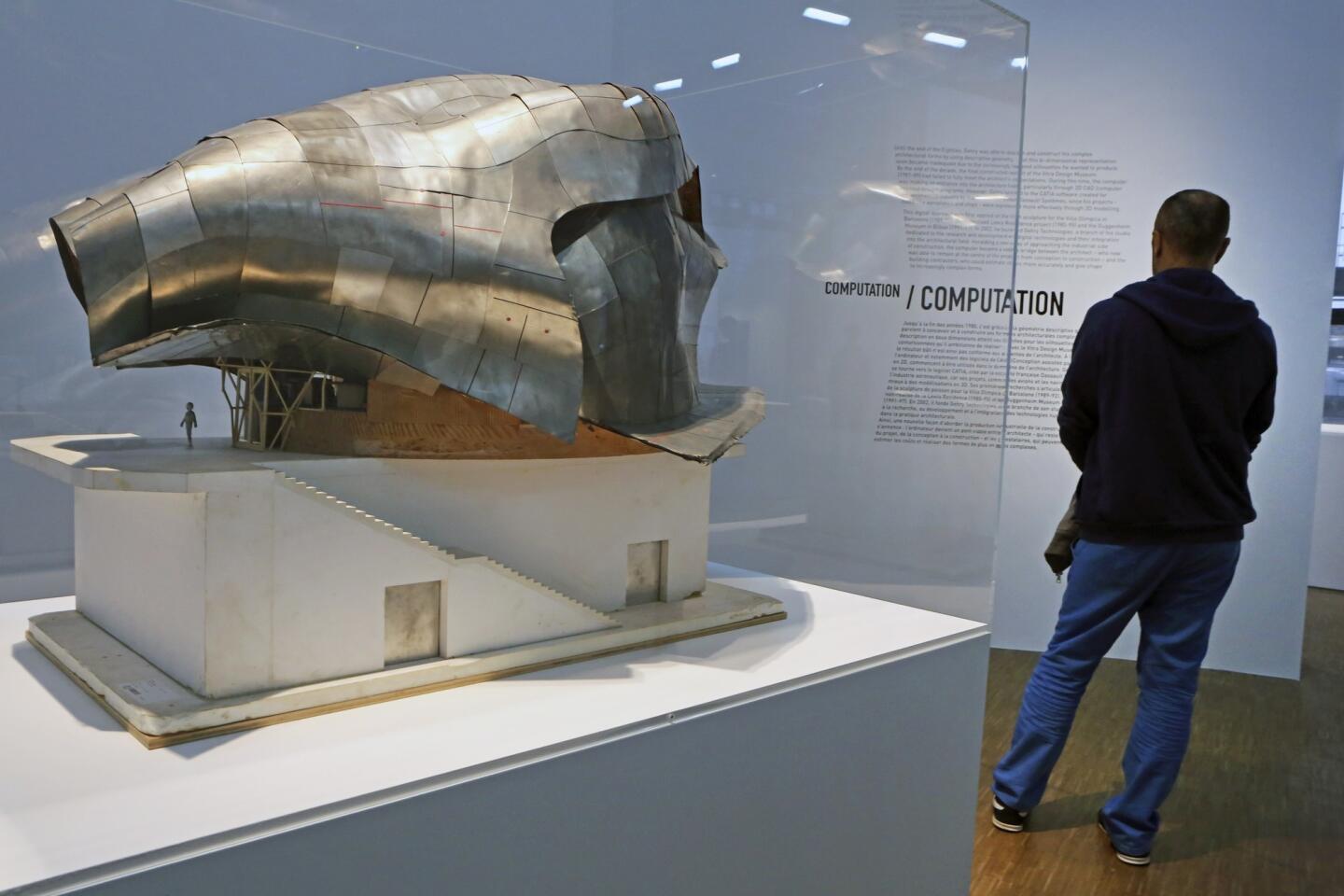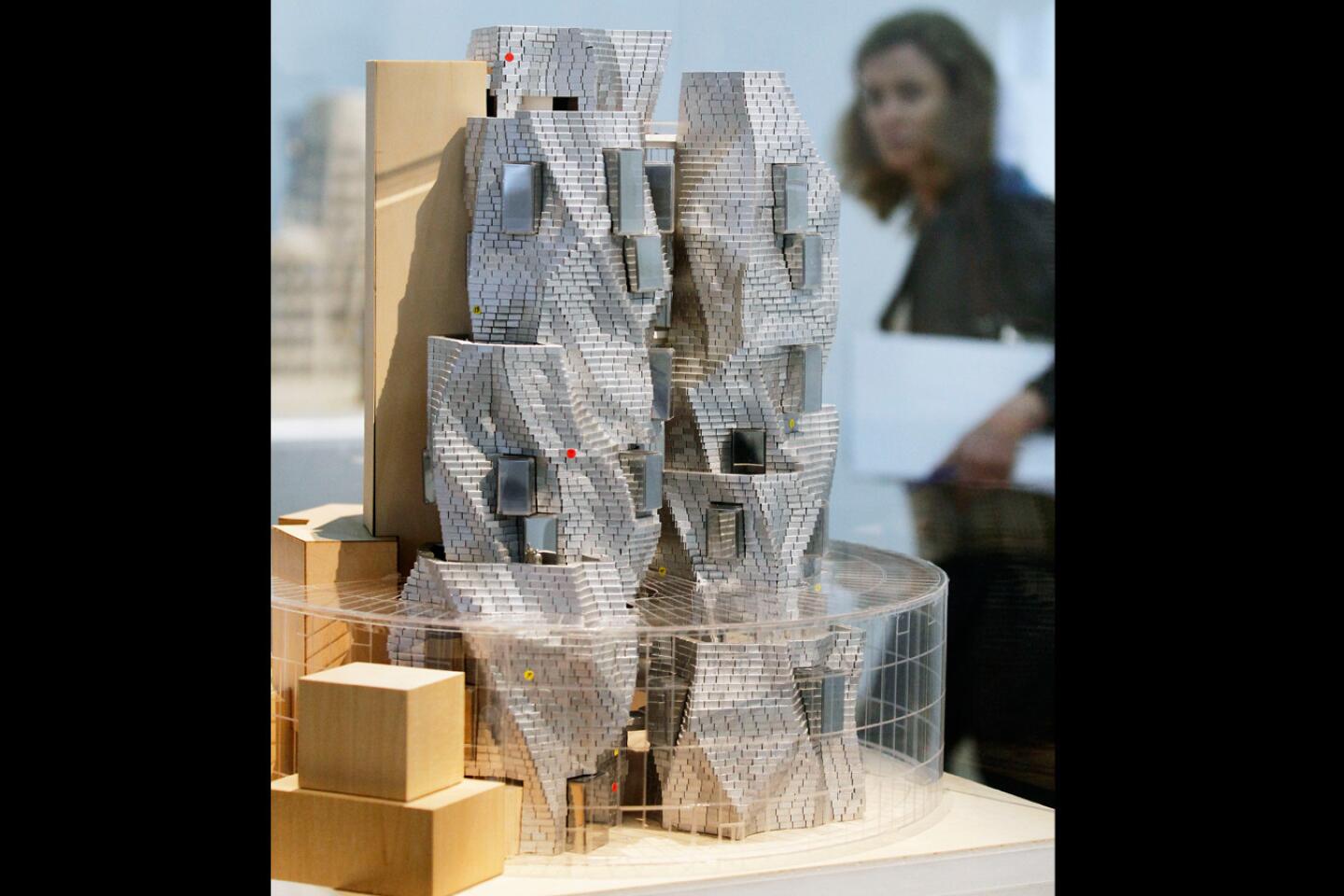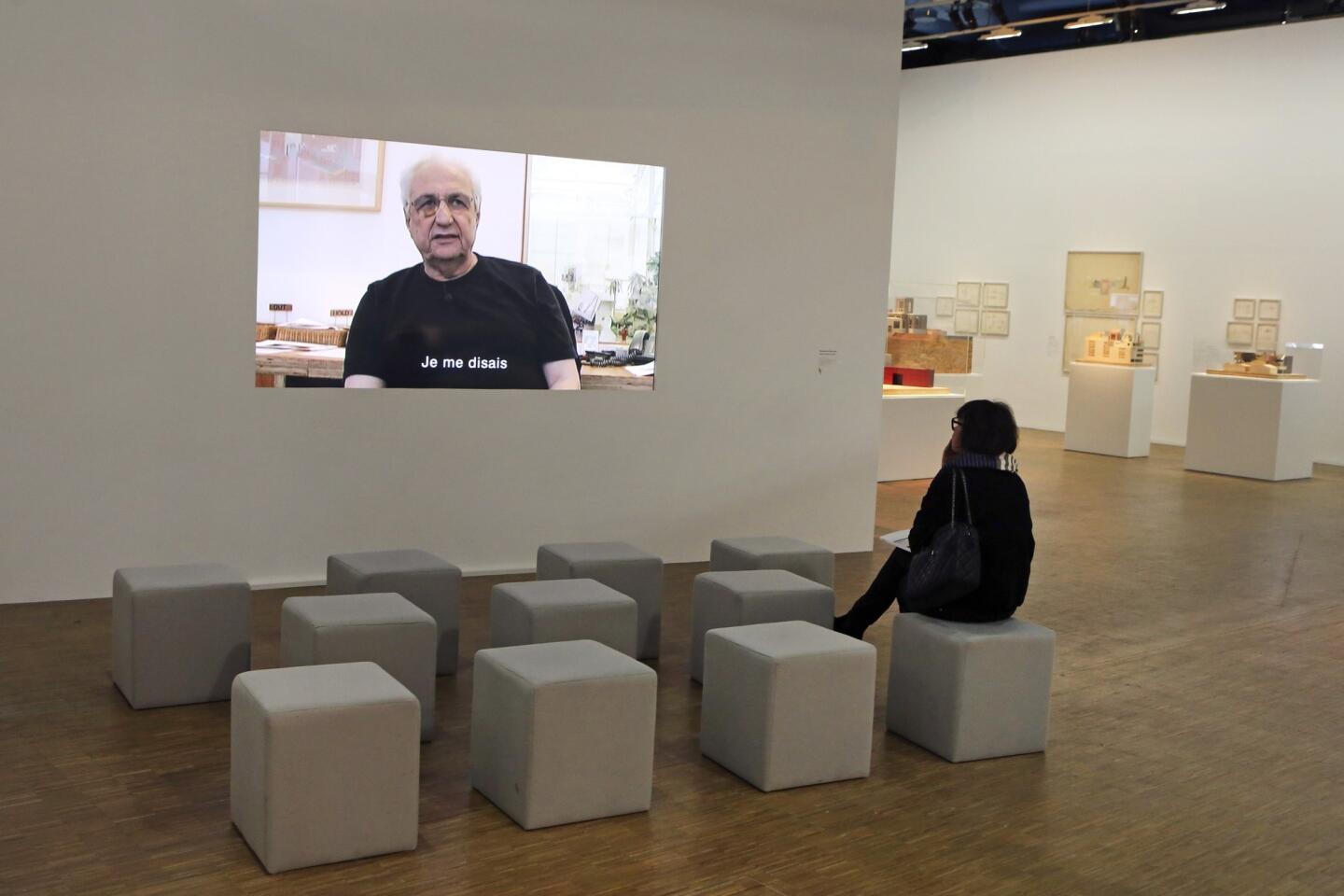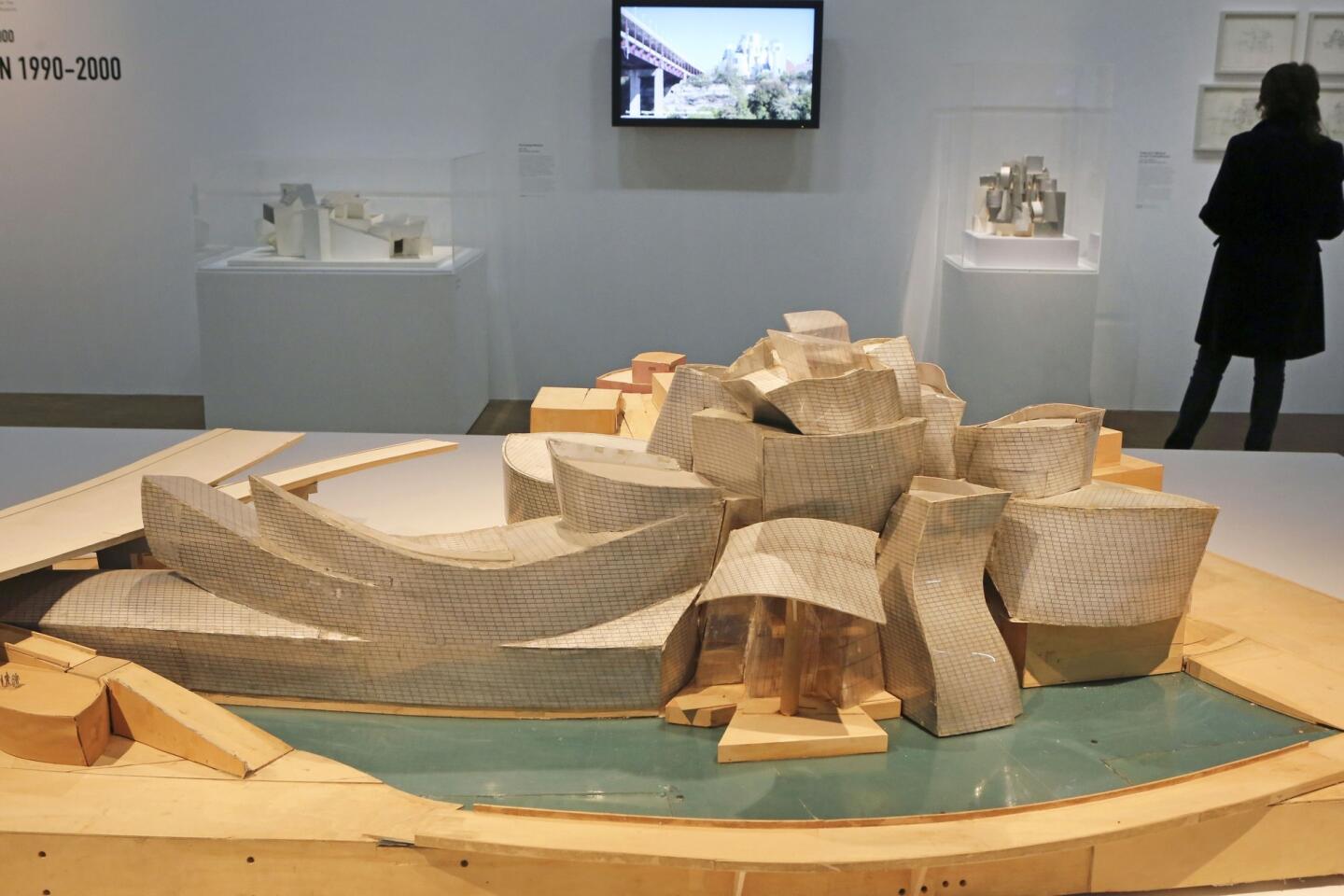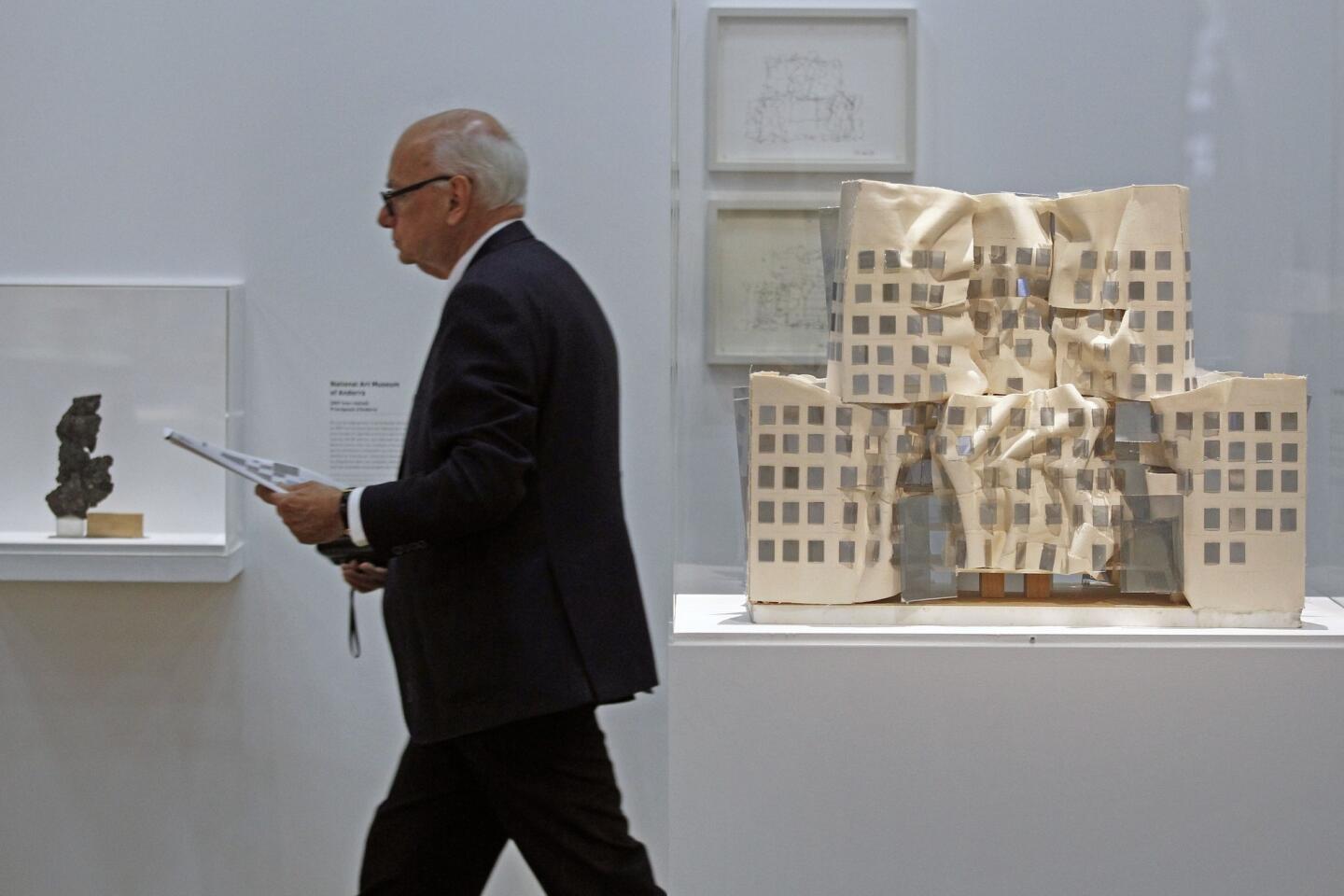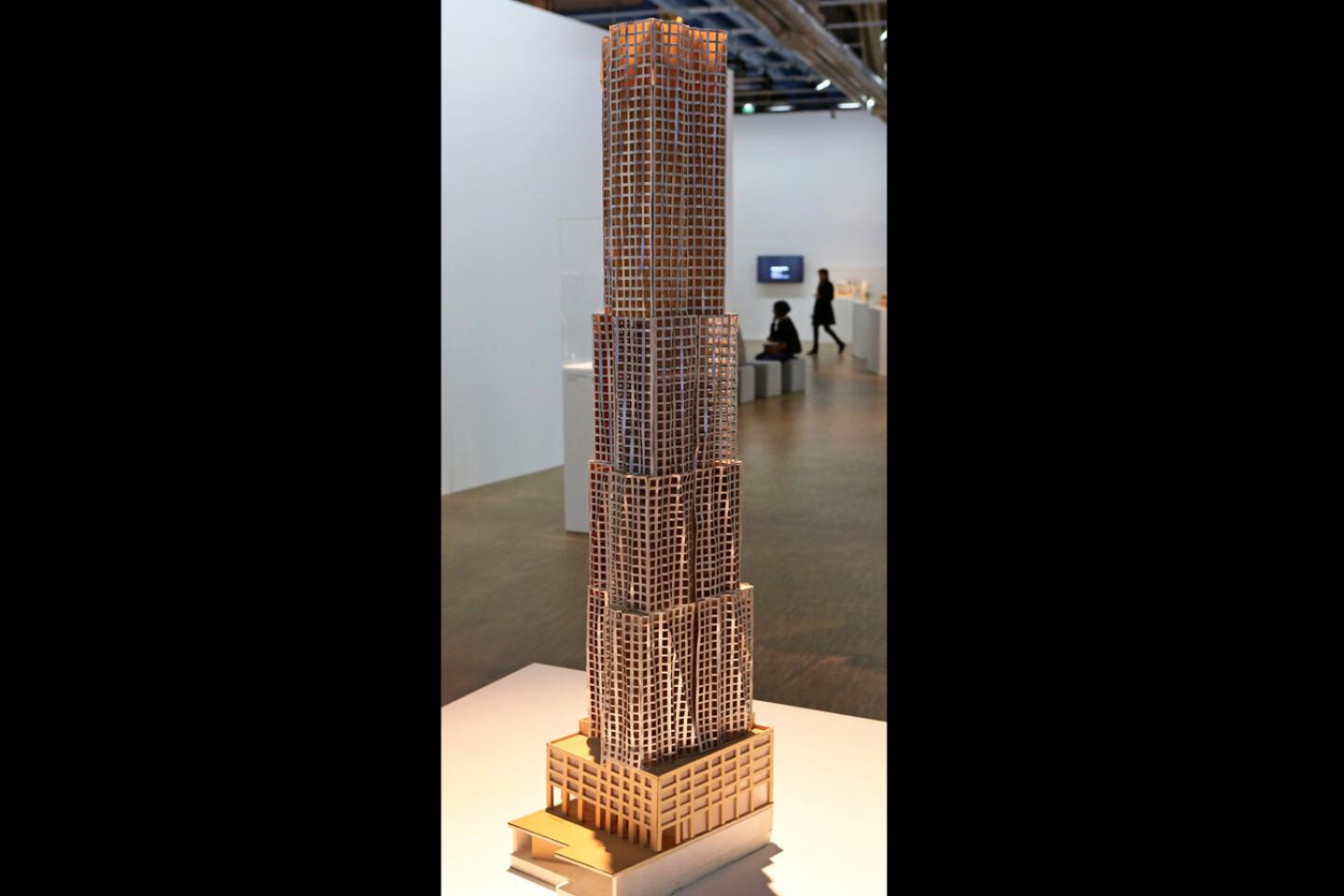Critic’s Notebook: Comprehensive ‘Gehry’ retrospective in Paris draws sociological blank
The ground-floor gallery at the Pompidou Center, where curators Frédéric Migayrou and Aurélien Lemonier have installed “Frank Gehry,” a major retrospective that runs through Jan. 26, looks right out through floor-to-ceiling windows toward the sidewalks of the 4th Arrondissement.
On both of the days I visited, people leaned or backed up against the glass or peered in through it, trying to catch a glimpse of the models, drawings and video screens on display. It was as if the outside world were pressing to get inside the show.
No such luck. The exhibition is an impeccable vacuum. The curators have worked strenuously, if invisibly, to keep at bay the full range of issues that have given the rest of the architecture world a full-on identity crisis in the last decade or so.
The curators cast Gehry in a well-worn mold: as one of the Great Men of contemporary architecture, a lone creative genius who has navigated a path from teenage Canadian immigrant in postwar Los Angeles to global superstar, churning out unorthodox houses, museums and concert halls all the while.
In fact, at this stage of his professional life, the 85-year-old Gehry has come to represent, perhaps as fully as anyone in the profession save Zaha Hadid, one side in a series of battles that have not just divided but reshaped architectural practice over the last decade.
Those battles begin with a dispute over how architecture is produced: whether it is fundamentally a collaborative or personal art. They also include a pitched fight over the importance of form-making — over the value of the iconic, photogenic project in architecture versus an approach that is more politically, socially or ecologically engaged.
The Louis Vuitton Foundation, Gehry’s ravishing new Paris museum for the French billionaire Bernard Arnault, is the latest reminder that he’s capable of making a singularly strong case for the sculptural and iconic project. There is a genuine humanism at the core of his work that helps protect him from charges that he is merely chasing showy projects from one continent to the next.
It is possible to move through one of his firm’s finest buildings — Vuitton or the Walt Disney Concert Hall, for example — and be (at least momentarily) convinced that architecture’s single highest calling, even in 2014, is to produce rooms that achieve a surprising kind of equilibrium and proportion without resorting to boxy and predictable geometry.
At this basic architectural skill, Gehry is far more accomplished than his detractors over the decades have given him credit for. And I agree with the curators, who include here a whole section on the urbanism of Gehry’s projects, that his firm is underrated in its ability to read and respond to civic and urban context.
But the truth is that this battle over the profession and its priorities is far from settled or clear-cut. In fact it continues actively to reorder not just architectural practice but urban planning, criticism and other related fields.
The Vuitton building is a perfect example: It is both a spectacular work of architecture and a challenge, thanks to the deal Arnault managed to strike to build in the middle of the Bois de Boulogne, to a deeply held set of beliefs in France about communal civic culture. To read it simply as one but not the other, as either sublime or compromised, is to make a point of ignoring the full range of ways in which architecture operates.
The curators divide Gehry’s career into six chronological phases, beginning with his earliest L.A. projects, after he left the office of planner Victor Gruen. The plain, even deadpan stucco boxes of those years, beginning with the Danziger Studio on Melrose Avenue of 1964, soon morph into compositions of detached, single-room buildings that owe something to the still lives of the Italian painter Giorgio Morandi.
The show then pivots on a pair of projects hinting at an entirely new, fluid and ultimately digitally enabled architecture. Both the Vitra Design Museum in Germany and the unbuilt but extensively redesigned Lewis House for a site near Cleveland reveal Gehry’s rising frustration with traditional building methods and design strategies.
The shift would ultimately produce the shimmering and fluid forms of the Guggenheim Museum in Bilbao, finished in 1997 and given appropriate pride of place here, as well as Disney Hall, opened six years later.
Along with a room dedicated to the Gehry office’s use of digital technology, the show finishes with a look at projects yet to be completed.
Throughout, the exhibition is made up of a carefully culled selection of framed drawings — highly varied in technique and approach, they are the big surprise of the show — along with models mounted on simple white pedestals and video screens showing a rotating group of projects. There is also a wall of 1970s photographs by Gehry of industrial buildings and warehouses that recalls the work of Ed Ruscha and Bernd and Hilla Becher, and also a small handful of projects from 1962, when he spent a year working in Paris for architect Andre Remondet and Robert Auzelle, a planner.
Even on its own narrow terms, the show misses some opportunities to demonstrate how Gehry works. It includes none of the extra-large models his firm uses as a central part of the design process. (Models of that giant scale energize a small exhibition at the Vuitton museum, curated by Migayrou, on that building’s design and construction.)
More to the point, you’ll find virtually no information about the role played by Gehry’s key partners over the years, who include Greg Walsh, Edwin Chan, Meaghan Lloyd and Craig Webb.
Other banished subjects include Gehry’s complicated relationship with Los Angeles, his adopted hometown; the uncertain fate of his proposed memorial to Dwight D. Eisenhower near the Mall in Washington, D.C.; the political uproar that greeted his plan, sponsored by Bruce Ratner, to drop more than a dozen separate buildings and an NBA area into the middle of Brooklyn; and recent controversy surrounding labor conditions for construction crews in Abu Dhabi, where Gehry’s firm is designing a massive Guggenheim satellite due to be completed in 2017.
Gehry has been more active than some of his famous peers in confronting this issue, hiring a human-rights lawyer to monitor worker safety on the Guggenheim.
Are these architectural subjects? More to the point, are they curatorial ones? Do they belong not just in catalog essays but in the galleries themselves?
Increasingly, museums are breathing new life into architecture exhibitions by insisting they do. The Museum of Modern Art in New York has mounted a series of design and architecture shows with pointed political and social themes. A number of younger curators who focus on architecture — Ruth Estevez, Joseph Grima, Henry Urbach and the Belgian collective Rotor — have widened the scope of their shows in similarly effective ways.
The Pompidou, with restraint and politesse, has walled off the Gehry show from those emerging approaches. To a certain extent that’s no surprise. Monographic shows of this kind often tiptoe around touchy subjects, edging in the worst cases toward hagiography. According to Lemonier, Gehry’s office worked closely with the Pompidou on the coolly handsome exhibition design.
But there are ways to acknowledge these larger issues without shortchanging the architecture itself, as those other curators have made clear. What distinguishes architecture from painting and sculpture, after all, is this obligation to and interaction with the broader world. And Gehry happens to manage that web of relationships far better than most.
All of which leaves the Los Angeles County Museum of Art with a dilemma. The Gehry show is scheduled to appear there next September. Stephanie Barron, senior curator and head of modern art at LACMA, will handle it for its L.A. run, which is reason for optimism.
The museum is hardly in a position, though, to assess Gehry’s work at a critical remove. The architect often works with Barron to design exhibitions for the museum.
What’s more, LACMA Director Michael Govan has been open about his desire to hire Gehry to design a new tower on property the museum owns on the south side of Wilshire Boulevard. He has also said he is interested in acquiring Gehry’s extensive archive, which could form the anchor of newly expansive architecture and design galleries at the base of the tower.
I’m glad Govan is bringing the show to LACMA; his tenure has been disappointingly light on architecture and design exhibitions. But figuring out how to tell the kind of story Gehry himself will sign off on at LACMA — and presumably help design — without ignoring the more complicated chapters of his career or the full complexity of his work?
Even for the politically nimble Govan, that will be a tricky task.
Follow @HawthorneLAT on Twitter.
More to Read
The biggest entertainment stories
Get our big stories about Hollywood, film, television, music, arts, culture and more right in your inbox as soon as they publish.
You may occasionally receive promotional content from the Los Angeles Times.
